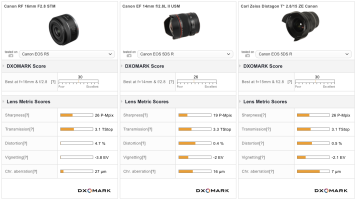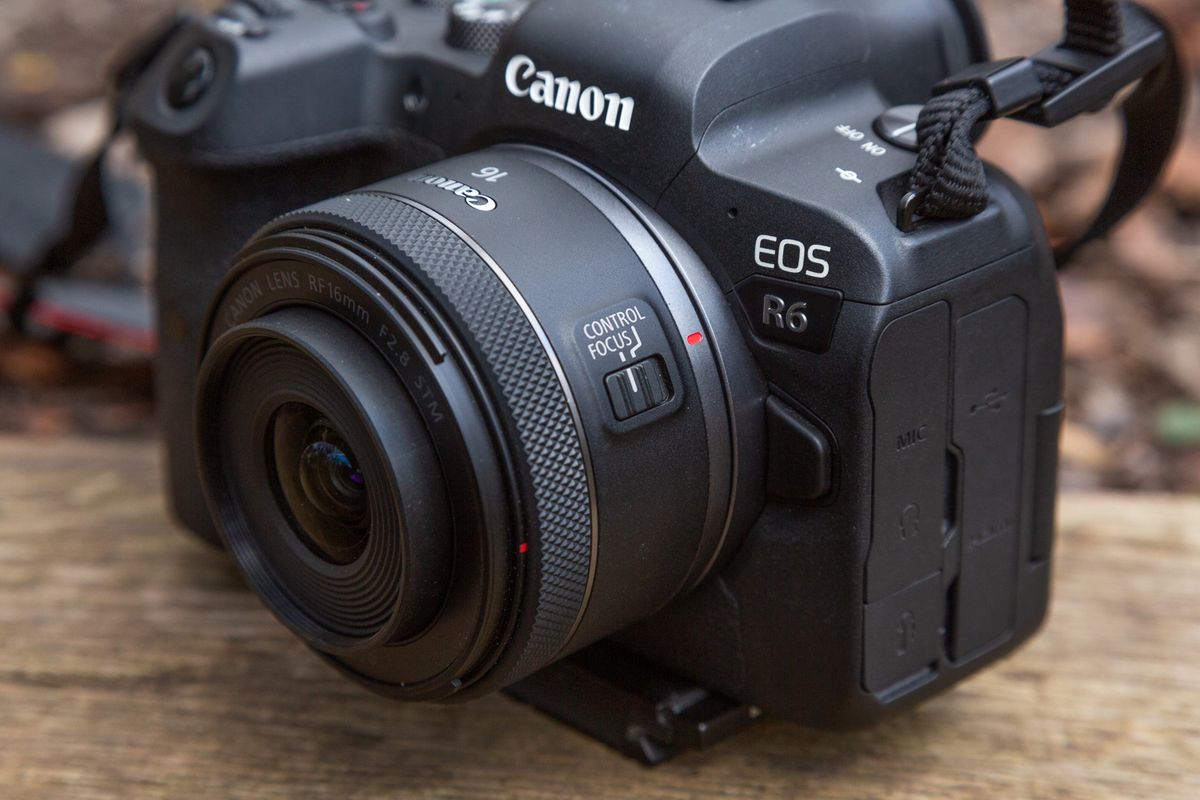Here is the list of ultrawide prime lenses that Canon has launched since the release of their first FF digital camera (the 1Ds) in 2002:
- EF 14mm f/2.8L II USM (2007)
- RF 16mm f/2.8 STM (2021)
It's a short list, but the RF 16/2.8 ranks in the top 2.

Do you think it's fair to compare an L lens costing $2100 with a consumer-grade lens costing $300? Well, just for fun let's check out DxO's measurements, throwing in a Zeiss 15/2.8 (a 2012 lens that launched at nearly $3000) for kicks:
View attachment 205726
Now, DxOMark's Scores are bogus (because they're based as much on the sensor as the lens) but their measurements (Metric Scores) are robust and generally reliable. Looking at those, the RF 16/2.8 is better than the 14/2.8L II on sharpness and transmission, matching the Zeiss lens costing 10x as much.
Bryan/TDP's ISO 12233-type testing (with the caveat that it's n=1 lens copies) shows that the RF 16/2.8 and the EF 14/2.8L II are pretty similar, with the 16/2.8 having a slight edge on center sharpness.
View the image quality delivered by the Canon RF 16mm F2.8 STM Lens using ISO 12233 Resolution Chart lab test results. Compare the image quality of this lens with other lenses.

www.the-digital-picture.com
I'm guessing these comparisons do not align with your intended point, maybe you'll pretend they doesn't exist – you seem to be pretty good at that!
No neuro, despite your gratuitous ad-hominem attack at the end (couldn't help yourself could you lol!) this is EXACTLY what I was asking for, so thanks for supplying this useful information.
This clearly points out what the reviews all stated, that a 16mm prime is a very niche lens, even amongst UWs, and that focal length on a crop sensor providing 25.6mm equivalent makes for a more useful 24mm focal length substitute.
The fact that only three UW primes around this focal length have been released in the last 20 years, with one from a third party both highlights Canon's reading of the market and the very niche nature of the prime focal length, which has been expanded with the need for lightweight vlogging lenses, which may have been the impetus to release the RF 16mm, and maybe their need for lightweight lenses on the RF-S platform if they've been planning on dropping the M-series. An R10 with a RF 16mm f/2.8 is a lightweight 24mm equiv travel/hiking setup that crops away the less sharp periphery.
These three lenses sit so far apart in their market tiers and prices that a like-for-like comparison is not really possible, but as we see, the cheaper RF lens is the worst in class, with:
- almost 10x more distortion (4.7% vs 0.4% and 0.5%)
- around 2x more vignetting (-3.8EV vs -2Ev or -2.1EV)
- over 1.5x more chromatic aberration (27um vs 16um or 7um)
So, it looks like nobody has really cared much about this class of lenses, the pickings are slim, and Canon's doing the marketing thing creating demand while playing catchup in growing vlogging market that boosted their sales of high-end compacts and then the M50 I and II series APSC bodies, a demographic of mainly younger people, and a market that Sony is all over now with dedicated cameras and lenses for this specific video genre.
Looking back at the Optical Limits review, we see that the limitations are constantly raised, offset against the consideration of price.
Distortion:
"...The lens produces a native barrel distortion of almost 10%! This is excessive, making it basically unsuitable for use without digital correction. The latter does an excellent job by reducing the issue to essentially zero. While this is commendable, there is a price to pay for this because the image is stretched substantially, thus reducing resolution in the outer image field."
Vignetting:
"...The vignetting is still heavy at f/2.8 but not terrible when stopped down, considering the ultra-wide nature of the lens. With full correction enabled, the results are quite good even at f/2.8 because the light falloff is very gradual from the center to the corners. Needless to say but the signal boost comes at the cost of increased image noise in the outer image field."
MTF (resolution) at 45 megapixels (EOS R5):
"...The Canon RF 16mm f/2.8 STM is just not designed for being used without correction. The resolution characteristic is fairly predictable from here. The broader center quality has no issues whatsoever. The lens is tack sharp here, especially when stopped down a little bit. The borders and corners are an entirely different story, though. The borders are Okayish at f/2.8, but the corners are a pixel soup at this setting. Stopping down lifts the borders to reasonable levels, but the corner softness improves only marginally. This is all a bit tragic because, unsurprisingly, the lens appears to be much sharper without distortion correction."
MTF (resolution) at 30 megapixels (EOS R):
"...As you can see below, the general theme remains similar - although the reduced megapixels are boosting the outer image quality (on pixel level) quite a bit. While there's still some softness at f/2.8, the results are actually decent at medium aperture settings."
The verdict sums it up perfectly - "...The Canon RF 16mm f/2.8 STM is a lens with many facets. It comes down to where you come from and what you want."
"...From a technical standpoint, the RF 16mm f/2.8 STM offers poor quality on a high megapixel camera. The broader center is perfectly sharp but the quality is falling apart in the corners. And that's with auto-correction. The lens is basically unusable in pure RAW mode with excessive barrel distortion, extreme vignetting and high lateral CAs. It's about as underdesigned as it gets and relies heavily on digital correction to lift it back from the imaging abyss."
Optical Quality: 1.5/5 stars (@45 megapixel)
Optical Quality: 2.5/5 stars (@30 megapixel)
Mechanical Quality: 3.5/5 stars
Price/Performance: 5/5 stars
from:
https://www.opticallimits.com/canon_eos_ff/1136-canonrf16f28
Who is this lens for?
"All and all, the RF 16mm F2.8 STM is easy to recommend to Canon R system owners who want to add a wide angle to the mix. It's a strong option for hobbyists getting started with an EOS RP, and more serious shutterbugs with an R6 or R5 can look to it as a lightweight option for travel and walks about town."
A slim, affordable prime with a wide angle view

au.pcmag.com
"Buy it if...
You’re on a budget
There's no doubt about it – at this price, this is a bargain for a capable, full-frame-ready lens. You won't do better than this in the RF system at this price point.
You like to hike to your photographic locations
Thanks to its 165g weight, you’ll barely know this lens is on your camera or in your bag. On long landscape trips, that's a big advantage over alternative lenses.
You like to go wide
This lens' 16mm view is a very practical, go-anywhere focal length and also handy for video, too.
Don't buy it if...
You don’t like image editing
It's by no means bad, but this lens' image quality is nonetheless a good example of the compromises you make when you shop at this end of the lens market.
You don’t like moving your feet
Feeling a bit lazy? Buy something that zooms, like the RF 15-35mm f/2.8L IS USM, or the rather cheaper and wider RF 14-35mm f/4L IS USM."
Basically weightless, ultra-wide and very practical

www.techradar.com
The limitations are stated time and again in every review, and the point is made that these compromises are expected in a lens of this price.
No, it's not a good lens technically or optically, as the reviews all clearly indicate.
Is it a lens worth buying? The reviews say yes, what it offers for the price is great, and it may be the lens for you, as the Optical Limits review, the subject of this thread states, " It comes down to where you come from and what you want", and that's the critical decision-making factor for potential buyers.
Are we really arguing against less-than favorable or mixed praise-criticism product reviews? I can't see what we're actually arguing here. Liking a lens and finding it works well for a person's needs doesn't invalidate the review test results, or tell us anything much about the lens, it just indicates that the lens's limitations don't significantly impact the person's intended use. Hooray!





